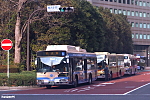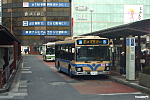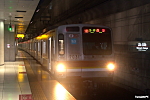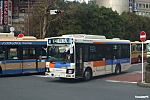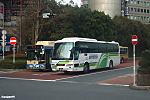Not logged in | Log in | Sign Up

Search Photos
Hino Blue Ribbon #4-3408
25 january 2019 - Yokohama (Kanagawa Pref.), Nishi-ku, Minami-saiwai 1-chōme (神奈川県横浜市西区南幸1丁目), Yokohama-eki Nishi-guchi bus terminal. Of course just because there is a municipal operator, it doesn`t mean that there are no other operators (well, more on that under further photos). Although two of the buses in the photo belong to the city, the middle one belongs to Kanachū, who operates seven routes from this terminus. Kanji-less numbering of three of them suggest routes operated together with the city, but as it turns out, only one of them (the express 62) is jointly operated by both municipal and private operators, with more departures by the latter - the other two, 1 and 5, are privately operated for nearly 13-14 yeras. Routes operated together by two different companies to this day remain a rather interesting mystery to me, given this is Japan which has no transport authorities at higher level (almost everything, no matter how you look at it, is commercial, albeit rather often profitable).

Author: TranslatorPS 

Place: 横浜市 [Yokohama-shi] (Kanagawa-ken)
| Owner: Kōtsū-kyoku 横浜市 [Yokohama-shi]
Comments: 2
Isuzu 2DG-LV290N2 Erga Non-Step #7-1826
25 january 2019 - Yokohama (Kanagawa Pref.), Nishi-ku, Minami-saiwai 1-chōme (神奈川県横浜市西区南幸1丁目), Yokohama-eki Nishi-guchi bus terminal.87: 横浜駅西口 (Yokohama Station West Exit) → 市民病院 (City Hospital) → 横浜駅西口 (Yokohama Station West Exit) (circular route)
Is this a normal route number? Yes! Yokohama City Bureau of Transportation does NOT use kanji characters in its route numbering. The number and scale of bus operations in Yokohama is slightly mind-numbing, but one way or another you got to somehow cover a 3.73 million population city, which aside from its metric ton of standard-length buses (!!) otherwise only relies on JR, Keikyū, Tōkyū, Sōtetsu, and its own two subway lines. A bit of interesting trivia about Yokohama: as an administrative unit, Yokohama-shi is the most populous city in Japan, however that`s not the case as a general urban unit, in which case it places second - if we can even consider the possibility of splitting out anyting in the wider Kantō agglomeration aside from arbitrary borders.


Author: TranslatorPS 

Comments: 2
Eidan 7000 #7031
25 january 2019 - Yokohama, Minatomirai Line Motomachi-chūkadai station.Yūrakuchō/Fukutoshin/Tōyoko Line diagram 13S: 713-142/B1413S/6xxx, Motomachi-chūkagai 14:06 → Hōya 15:41
There was a human-related incident on the Seibu Ikebukuro Line that day, and as a result through trains onto the subway and Tōkyū lines were slightly thrown off schedule. According to schedule, this train no. 713-142 should have departed from here at 14:06 - I took the photo at 14:12, while a certain stock allocation tracking website has a note stating "13S 31F 14:13 delayed departure from Motomachi-chūkagai" (I wasn`t the one to put it there), which to be honest isn`t all that bad for a post-accident mess - sometimes such an accident, or to be direct, most often a suicide results in the schedule gone out the window for the next 3-5 hours.


Comments: 4
Isuzu SKG-LR290J2 Erga Mio Non-Step #5759
25 january 2019 - Yokohama (Kanagawa Pref.), Nishi-ku, Minami-saiwai 1-chōme (神奈川県横浜市西区南幸1丁目), Yokohama-eki Nishi-guchi bus terminal.浜4 (hama-4): 保土ヶ谷駅東口 (Hodogaya Station East Exit) → 横浜駅西口 (Yokohama Station West Exit)
If anyone of you thinks that I`m going to run out of Japanese bus operators, they`re getting closer and closer to the mark. Sōtetsu Bus is closely related to the railway with the same name, which currently operates three lines, with the main terminal some 200 metres behind me. The bus operations area is closely related with the railway service area. The most curious thing of all is however the route number - although the kanji+number scheme is nothing new in the Tōkyō agglomeration, what is new is the kanji character being selected not from, for example, the nearest railway station, but... the operating garage! As a side effect there is a plethora of 旭 (asahi) routes without a single railway station in the area using this character (two of these terminate here anyway).


Author: TranslatorPS 

Comments: 4
Mitsubishi Fuso KL-MS86MP Aero Bus #6566
25 january 2019 - Yokohama (Kanagawa Pref.), Nishi-ku, Minami-saiwai 1-chōme (神奈川県横浜市西区南幸1丁目), Yokohama-eki Nishi-guchi bus terminal. Today`s lot of photos comes from this terminal. Sōtetsu has some intercity bus connections from Yokohama station towards Mount Fuji - judging from the current timetable, this bus arrived from there. In terms of other coach connections, just as any bus operator in the Tōkyō area should have, there is a Haneda airport route (only from Futamatagawa and shared with Keikyū, but still; the Ebina route is currently suspended).

Author: TranslatorPS 

Place: 横浜市 [Yokohama-shi] (Kanagawa-ken)
| Owner: Sōtetsu Bus 横浜市 [Yokohama-shi]
